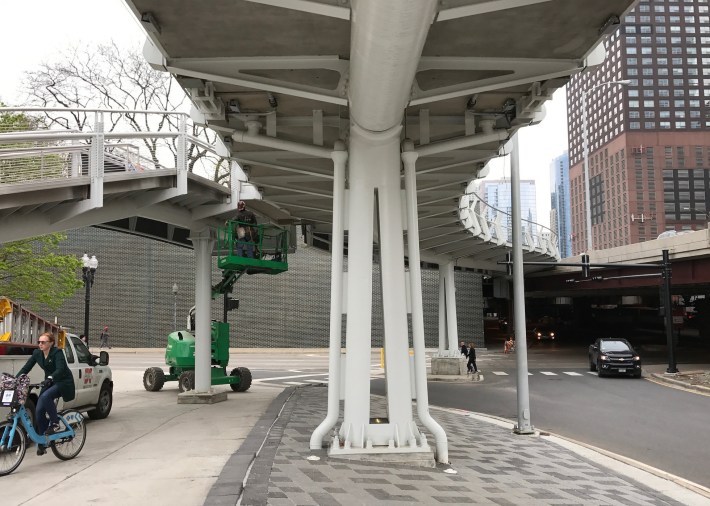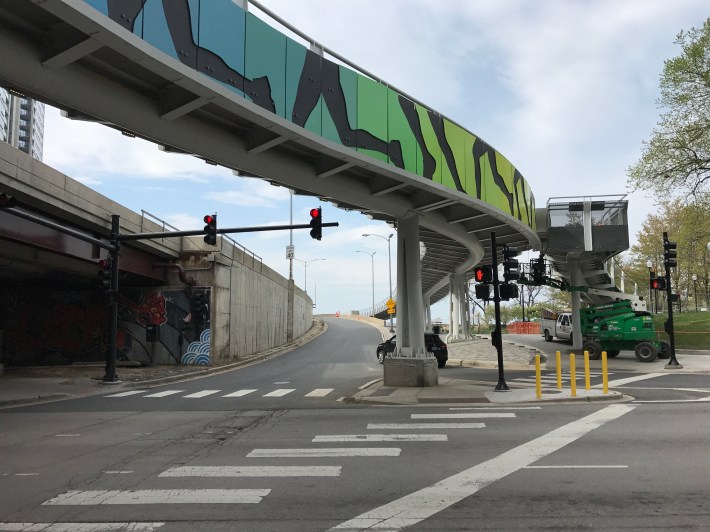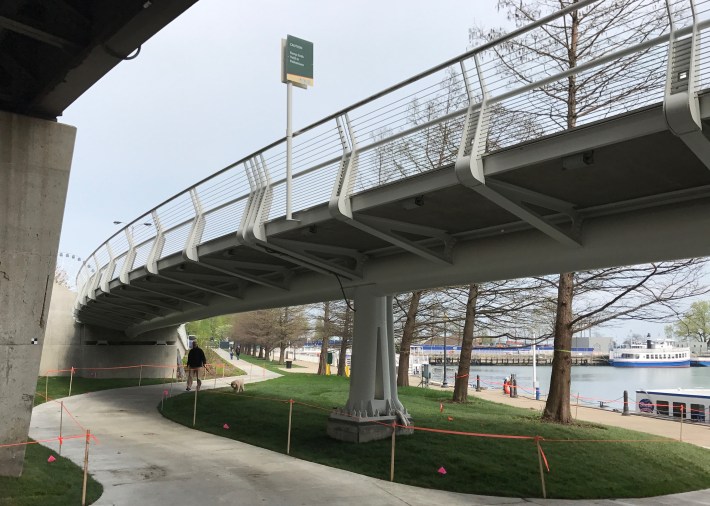[The Chicago Reader publishes a weekly transportation column written by Streetsblog Chicago editor John Greenfield. We syndicate a portion of the column on Streetsblog after it comes out online.]
Thankfully, the 40-year-old bicyclist who was struck by a Suburu driver near the Navy Pier Flyover construction site last week wasn't seriously injured. But the crash sparked a new conversation about why the $60 million initiative to build an overpass for cyclists and pedestrians, to improve safety near Illinois's second-most-popular tourist attraction, is taking so damn long.
The flyover is meant to relieve crowding on a narrow section of the Lakefront Trail between the Chicago River and Ohio Street Beach. Currently this stretch of trail is just a narrow sidewalk along Lower Lake Shore Drive, with poor sight lines at the busy Grand and Illinois junctions. According to Illinois Department of Transportation data, there were a total of six reported bicycle and pedestrian crashes at these two intersections between 2009 and 2015.
The serpentine overpass, which resembles a spinal column when viewed from below, will widen the path to 16 feet, eliminate dangerous street crossings, and provide breathtaking views of Lake Michigan by taking trail users alongside Upper Lake Shore Drive and back down again.

Chicago bike advocates have been pushing for the flyover since before 2001, when the first public meeting on the proposal was held. But the project didn't really get rolling in earnest until Mayor Rahm Emanuel took office in 2011.
"We at the city have discussed this, we have debated it, we have deferred it for decades, and now it's time to build it," Emanuel said at the 2014 groundbreaking. At the time, CDOT announced that the overpass would be completed in 2018, which means the project is technically still on schedule.
According to police, the cyclist hit last week was riding west on Grand when he was struck by the driver, who was coming from the southbound exit ramp of LSD. That means that, even if the flyover had already been open, it wouldn't have made a difference in this case.

Still, the story inspired a thread on the Chainlink, a social networking site for local cyclists, in which members wondered aloud why, three years after the groundbreaking, the flyover still isn't finished.
For example, a commenter named Jim Reho noted that, incredibly, it's taking as long to construct the overpass as it took to build the entire Golden Gate Bridge. That massive span was built between 1933 and 1937 with far less sophisticated equipment.
Some people also argued that the roughly three-block bikeway is a waste of federal transportation funding that could be better spent on other cycling projects.
"It makes me weep to think of how much good could have been done for cyclists and pedestrians in Chicagoland for the $60 million they're wasting on that ill-conceived boondoggle," Reho wrote.

In comparison, all the hardware for the Divvy bike-share system, including 580 stations and 6,000 cycles, cost about $36 million, according to CDOT. (As with the flyover, most of the money came from federal transportation grants.)
The day after the Grand/Lower LSD crash, I got a message from one of the anonymous creators of a new Facebook page called Complete the Navy Pier Flyover. And Soon. The sender told me there are three people involved with the campaign, but they need to remain anonymous to avoid jeopardizing their day jobs. He or she said the group was "organized to put pressure on the city to complete the Navy Pier Flyover without further delays. With increased usage on the [existing trail], we are very concerned about public safety."
Active Transportation Alliance director Ron Burke has also expressed concerns about the construction time line, calling the overpass "a worthwhile investment given that it's such a busy bike/ped corridor," but adding that he's "disappointed it's taking so long."

When I alerted CDOT spokesman Mike Claffey to the recent complaints, he blamed the construction schedule on the project's complexity and cost. The new bikeway has to snake around on- and off-ramps for the Drive and pass through a Chicago River bridge house, and construction has required temporary lane closures.
Phase one of the project, from Ohio Street Beach to the Ogden Slip (a man-made harbor just north of the Chicago River), will cost $26 million, including $18 million in federal and and $8 million in IDOT funds, and is nearly finished.
"We knew from the outset that it . . . would be a challenge to fund [the flyover]—especially without a state capital bill or a dedicated federal funding source," Claffey says. "In order to get the project completed within our existing resources, we have had to spread it over several years."
While there was a tight deadline to complete phase one, Claffey says the city needed more time to line up funding for phase two—from the Ogden Slip to the river, starting this summer—and phase three—the southernmost flyover portion crossing the river, slated to start this fall.

"The three phases started design at different times and have been progressing on separate tracks," Claffey says.
A commenter on the Chainlink thread named Jorge defended CDOT's explanation of the project's cost leading to its seemingly slow completion.
"Why is it taking so long? Funding is spread out over years. It is that simple."
He scoffed at the idea that the grassroots Complete the Navy Pier Flyover. And Soon campaign could accelerate the project. "There is no possible way for that to happen," he wrote. "Might as well pray for it to happen sooner. Same effect, nothing."
Jorge also pushed back at the notion that the $60 million project is a boondoggle, noting that it will prevent crashes and injuries, and improve access to Navy Pier. "When are cyclists ever afforded luxuries in our car culture?" he wrote.
Jorge's got a point. We often take massive expenditures to facilitate driving for granted. Last week, for example, the Illinois Tollway board voted unanimously for a $4 billion expansion of the Tri-State Tollway. That's the equivalent of 67 Navy Pier Flyovers. It's about time that bike riders and pedestrians got some Cadillac-quality infrastructure for a change. While it would have been nice to see the flyover project expedited, in about a year and a half trail users' patience will be rewarded with a first-class facility.





